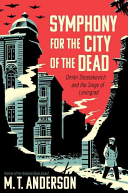2018 School Spending Survey Report
Symphony for the City of the Dead: Dmitri Shostakovich and the Siege of Leningrad
464p. bibliog. ebook available. index. notes. photos. Candlewick. Sept. 2015. Tr $24.99. ISBN 9780763668181.
COPY ISBN
 Gr 9 Up—This ambitious and gripping work is narrative nonfiction at its best. Anderson expertly sets the scene of the tumultuous world into which Dmitri Shostakovich was born in 1906 and traces his development as an artist and a public figure. He also tells the story of the composer's beloved Leningrad, focusing on the creation and legacy of the symphony written in its honor at the height of World War II. In his author's note, Anderson poses an intriguing question: "How do we reconstruct the story of someone who lived in a period in which everyone had an excuse to lie, evade, accuse, or keep silent?" The compelling, well-researched narrative relates what is known of Shostakovich's story, what is speculation, what is revisionist history, and what new sources have revealed. The chilling details of the Stalin regime and the plight of the Russian people even before the Germans arrived will be eye-opening to many teen readers. The book has all the intrigue of a spy thriller, recounts the horrors of living during the three year siege, and delineates the physical oppression and daunting foes within and outside of the city. This is also the story of survival against almost impossible odds. Through it all, Anderson weaves the thread of the composer's music and the role it played in this larger-than-life drama.
Gr 9 Up—This ambitious and gripping work is narrative nonfiction at its best. Anderson expertly sets the scene of the tumultuous world into which Dmitri Shostakovich was born in 1906 and traces his development as an artist and a public figure. He also tells the story of the composer's beloved Leningrad, focusing on the creation and legacy of the symphony written in its honor at the height of World War II. In his author's note, Anderson poses an intriguing question: "How do we reconstruct the story of someone who lived in a period in which everyone had an excuse to lie, evade, accuse, or keep silent?" The compelling, well-researched narrative relates what is known of Shostakovich's story, what is speculation, what is revisionist history, and what new sources have revealed. The chilling details of the Stalin regime and the plight of the Russian people even before the Germans arrived will be eye-opening to many teen readers. The book has all the intrigue of a spy thriller, recounts the horrors of living during the three year siege, and delineates the physical oppression and daunting foes within and outside of the city. This is also the story of survival against almost impossible odds. Through it all, Anderson weaves the thread of the composer's music and the role it played in this larger-than-life drama.
VERDICT A must-have title with broad crossover appeal—Luann Toth, School Library Journal
This ambitious, sometimes unwieldy, work encompasses the life of composer Shostakovich, the early political history of the U.S.S.R., and the nation's suffering during WWII. Initially inspired by the Bolshevik Revolution, Shostakovich's music changed during Stalin's Reign of Terror. The centerpiece is his Leningrad Symphony, which offered both catharsis and hope. Extensive black-and-white photographs help define the wide range of subjects and settings. Bib., ind.
,
Sep 01, 2015 RELATED
ALREADY A SUBSCRIBER? LOG IN
We are currently offering this content for free. Sign up now to activate your personal profile, where you can save articles for future viewing





Be the first reader to comment.
Comment Policy:
Comment should not be empty !!!